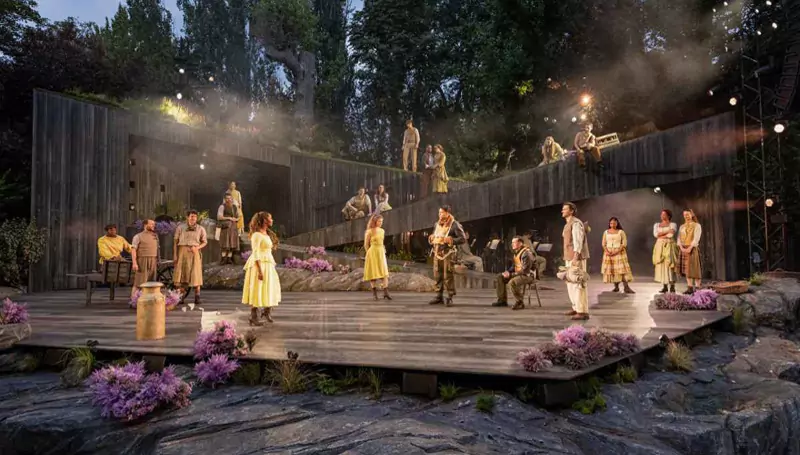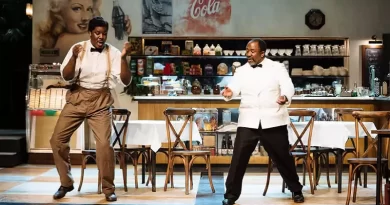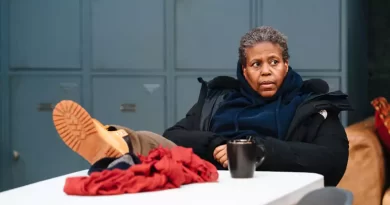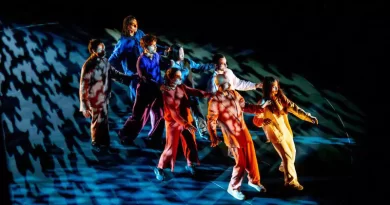“Brigadoon”, Regent’s Park Open Air Theatre
Jeremy Malies in central London
14 August 2025
★★★
Drew McOnie is both director and choreographer for the last show in his opening season as artistic director of Regent’s Park Open Air Theatre. This certainly makes for a coherent vision of Lerner and Loewe’s odd 1947 work.
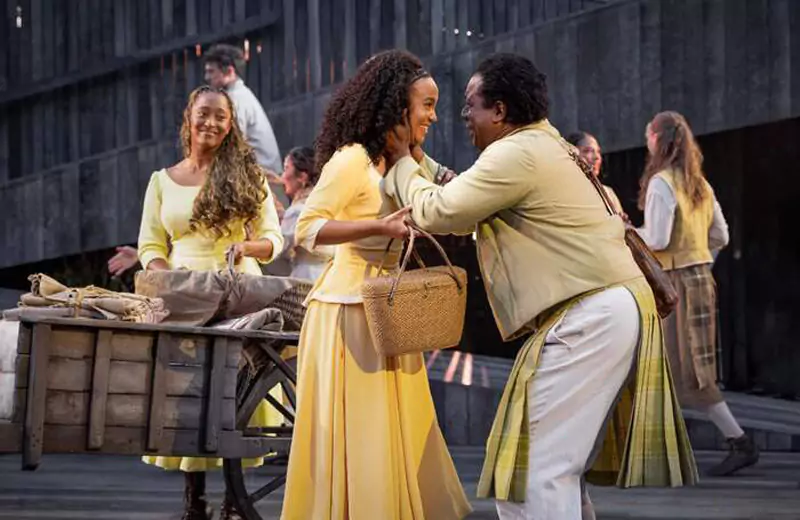
Danielle Fiamany, Jasmine Jules Andrews and Edward Baruwa.
Photo credit: Mark Senior.
The plot here has a pair of American World War II airmen (tourists on a hunting trip with car problems in the original) crash-land in the Highlands. They come across a village that does not appear on their map. It’s called Brigadoon and the people they meet seem to be living a couple of centuries in the past.
Later we learn that in the run-up to the Jacobite rising of 1745, a spirit that protects the village has struck an odd deal with the deities. To avoid harm, Brigadoon will only come to life and be visible to outsiders for a single day every hundred years. If you enter the village, you can coexist (and of course fall in love) with the locals. And you can stay. But if you leave you can never come back. So far so good, formulaic, fairy-tale stuff and frankly preposterous but there of course lies the charm as well as the unwieldy nature of the plot.
Just occasionally I lost focus and thought there may be reasons why the piece hasn’t been done in London for 36 years. But I was soon jolted back into a state of attention not so much by the songs (there is barely a number that you would walk through the park humming on the way out) but by the subtlety of the libretto which has much to say about men’s experience of loneliness. Tommy’s song “There But for You Go I” is all about loneliness.
Previous productions in the United States and a film version featuring Gene Kelly have been accused of cultural appropriation in terms of stereotypical handling of the Highland backdrop. The adaptor here is playwright Rona Munro who was raised near Aberdeen. There are many other Scots among the cast and creative team.
Munro immediately raises things above possibly twee elements such as ghillies and the hunting and shooting described in Alan Jay Lerner’s book. In this, Munro is helped by Basia Bińkowska’s set which avoids being broad brush. The stage design includes convincing recesses such as the bothy in which Meg (Nic Myers) hopes to seduce Jeff (Cavan Clarke).
This pairing is the subsidiary couple, and the focus is on Louis Gaunt as Tommy and Danielle Fiamanya as Fiona. Fiamanya (who performed on press night) is in a job share with Georgina Onuorah. Gaunt has the sheen of a fresh modern tenor with a style that is lean but ardent. Fiamanya, a full lyric soprano, is a tad too operatic in style for the exchanges in the signature song “Almost Like Being in Love” to seem in any way spontaneous. But I believed absolutely in Gaunt when he tells Fiamanya that he thinks she is marvellous.
Elsewhere, musical director Laura Bangay integrates score and the actions of ensemble members tightly. Helped a little by drizzle on press night, Jessica Hung Han Yun creates a lighting design that often renders the background misty such that the vaguely supernatural goings-on appear to be against the gloaming.
The stand-out performance, at least for me, is Danny Nattrass playing lovelorn Harry. I saw a lot of Jud Fry from Oklahoma! in his self-loathing though here it is set off by exuberance and technical skill in his sword dance and contributions to the group reels. Harry’s dilemma and lack of restraint are the muscle of the piece for me, and Nattrass ensures that his dance gels with the general action. McOnie frames the piece in part as a ballet and finds movement patterns and discipline in doing so. Harry is a reminder that Munro is unafraid to deal with the darker dimension.
McOnie in no way obsesses on the dance elements and excels with the drip-feed of information about time setting and what for the Americans is anachronistic clothing until they notice dates inscribed in a family Bible. The scene in which the penny drops is exquisite. Despite the folk idiom, the kilts, abundance of plaid, and theme of Scottish frugality, this is never schmaltzy. And the many good gags, such as drinking to one’s last hours of freedom before marriage, come over well.
I have some reservations but overall I had a good time. I wouldn’t echo Tommy and say that this invigorated me such that “I could swim Loch Lomond and be home in half an hour”. But there are moments in the part-singing when this truly soars. I often reflected that I cared about these people.
With current world politics being unusually fetid, what a grand idea it is for a place to never be alive in any one century long enough to be polluted by it. The musical is a brave choice and eminently logical for the venue since Lerner places almost every scene outside. The premise might be complicated but the sentiments on view are universal.

